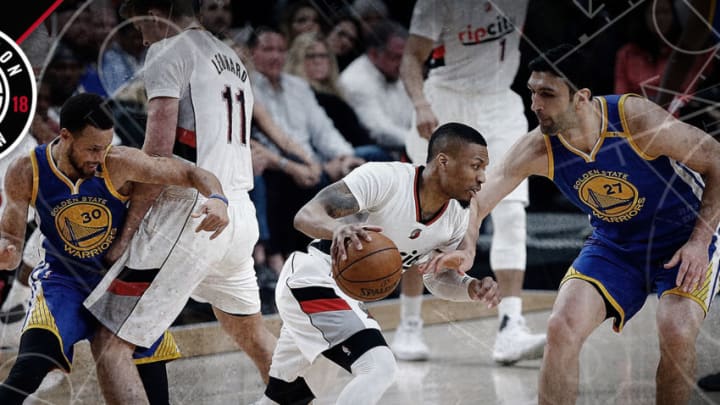The Trail Blazers are famous for their flare screens — off-ball screens that take the recipient away from the ball. Portland uses them for a wide variety of players, from shooters like Damian Lillard to drivers and post threats like Evan Turner.
Blazers head coach Terry Stotts has his team set more flare screens than just about any other team in the league, and they can have a devastating effect on unsuspecting defenders. However, as flare screens have risen in popularity across the league and teams are more in tune with what the Trail Blazers are running, Stotts has had to come up with new and different ways to use them to his team’s advantage.
“Flare Spain” combines two of the more recently popular actions NBA teams are running: the flare screen and the Spain pick-and-roll, popularized by — you guessed it — the Spanish national team. A big man sets a ball screen for the point guard on the perimeter, but in the Spain pick-and-roll, a wing is also involved, setting a back screen on the big man’s defender and forcing perfect communication between the three defenders involved to cover all the options.

Stotts combines this with his patented flare screen to put even more pressure on the defense:
Turner begins the play in the paint before cutting toward the top of the key and running off a flare screen to the weak side. Noah Vonleh’s defender follows Turner for just a half step, at which point Vonleh steps into a ball screen for CJ McCollum to begin the Spain pick-and-roll action. Allen Crabbe pops up behind Vonleh at the same time, setting a quick screen on Clint Capela before popping out to the 3-point line, where he’s wide open after Capela and Patrick Beverly both stay with McCollum and Lou Williams switches onto Vonleh to prevent the easy roll to the basket.
The Spain pick-and-roll itself requires the defense to execute with no failures — the Trail Blazers took advantage of the Rockets’ poor communication and execution in the above clip to create a wide-open 3-pointer. Even when the defensive team plays it the right way and covers everything, though, they’re often off balance and switched into matchups they don’t prefer, allowing McCollum and Lillard to operate in near-optimal conditions.
Watch how the Wizards defend the “Flare Spain” action perfectly but still give up a basket due to McCollum’s individual skill:
For Washington, this is about as good as it gets defensively. They defend the flare screen without giving up the open 3-pointer to Crabbe, then the three-man unit of Brandon Jennings, Ian Mahinmi and Kelly Oubre navigates the Spain pick-and-roll without giving up an open shot or a switch the Trail Blazers can exploit. But by doing everything correctly, Oubre still has to bump the rolling big man, Meyers Leonard, which opens up the only hole McCollum needs. As Oubre closes out to McCollum on the perimeter, he’s slightly off balance and has already put in a ton of work, both mentally and physically, to get the Wizards to where they are in the possession.
McCollum runs a little dribble pitch action with Leonard and Oubre and Mahinmi are unable to defend the baseline jumper. Even if Mahinmi closed hard on McCollum, Leonard was wide open for a catch-and-shoot jumper, as Oubre was still recovering from the screen and was in no position to get back to Leonard if McCollum had hit him with the pass.
Next: Five big questions from the craziest offseason in NBA history
Portland plays a back-and-forth chess game with their opponents, leveraging defenses’ knowledge of their reliance on flare screens to open up other actions. The “Flare Spain” action puts immeasurable pressure on the defense to get their positioning and communication right, and more often than not something that doesn’t happen allows the Trail Blazers an open shot.
